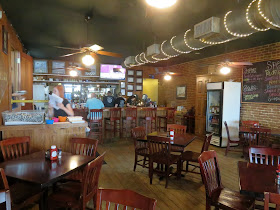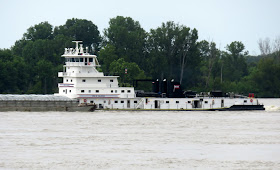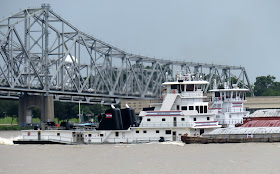Just
one more posting from our visit to Natchez Mississippi…
This is
a view downriver from the Under-the-Hill neighborhood. The view shows the Natchez
Mississippi/Vidalia Louisiana twin cantilever bridges over the broad
Mississippi River. We crossed them
headed west to our next major stop…
These
bridges are all used by US Highways 65, 84 and 425. They aren’t exactly twins as the oldest span,
(now carrying the westbound traffic), was built in 1940. The newer eastbound span was completed in
1988. These bridges are about 4,200 feet
long…about 8 tenths of a mile. At 125
feet above the water, these are the tallest bridges in Mississippi.
Looking
south along the riverfront, this unassuming building is the Magnolia Bluffs
Casino. Via a steep road, the casino is just
below the bluff where the main downtown area of Natchez is situated. The casino has over 450 slot machines, 16
table games and a live poker room as well as 3 restaurants. The associated Magnolia Bluffs Hotel is up on
top of the bluff on Canal Street.
FYI…I
actually walked out of the casino with more money than I had when I went
in! I was up $18.50!
For more information on the casino and hotel,
go to http://www.magnoliabluffscasinos.com/.
What
can I say! I like boats, ships, cars,
trucks, planes and trains…and I don’t get to see too many ships and big boats
in East Tennessee.
This is
the “Bettye M. Jenkins”. She was moored
across the river from Natchez in Vidalia Louisiana. As a matter of fact, she was built in 1959 by
the Vidalia Dock and Storage Co., Inc.
She is small in comparison with most of the towboats I saw…measuring
only 58 feet long with a beam of 20 feet.
Her original name was the “Shelia Ann Parker”.
This is
the “Vidalia Dock”. This 100 foot long towboat
was built in Greenville Mississippi back in 1968. She has had quite a history, having been sold
to 7 different owners over the years.
Her original name was the “Bessie Burton”, then the “Harewood”, later the
“Senator Sam” and finally the “Dana Jo” before she was acquired and renamed
again by the Vidalia Dock and Storage Company.
She burned in 1975 and was rebuilt in Ohio. Then she burned again in 1977 and was rebuilt
a second time, this time in West Virginia.
Perhaps
much to my reader’s satisfaction, I couldn’t identify this very large towboat
that was seriously in need of fresh paint… But it did get me wondering. Just how big do these towboats get?
Factoid:
Appropriately
enough, the largest diesel towboat on the Mississippi River is the “M/V
Mississippi”, which is operated by the United States Army Corps of Engineers.
The “Mississippi”
was built in 1993. It’s 241 feet long,
58 feet wide and it has a shallow draft of only 8 feet. It has a crew of 36. Most of the time it’s moving barges,
equipment and supplies in support of mat sinking operations. It also serves as an inspection boat for the
Mississippi River Commission during a high- and low-water inspection trip each
year. Commissioners hold meetings at
river towns in the boat's hearing room which can seat 115 people. Its dining
room can seat 85 people. The “Mississippi” has 22 staterooms and can handle 150
passengers.
One
final towboat… This is the “Paula A. Fortier”, a “Z Drive” 100 foot towboat
owned by the Southern Towing Company based in Memphis Tennessee. She was built in 2013. Southern Towing Company owns and operates 26
towboats ranging in size from 90 feet to 147 feet.
Enough
about towboats… On to the food!
This little
unassuming restaurant in Natchez’s Under-the-Hill neighborhood is the Magnolia
Grill. Although it looks very old, it
was actually constructed in 1990 by the family who is responsible for the
preservation of most of the buildings on Silver Street. The restaurant was built to look like the
saloon that originally occupied this same spot.
The dining
room has a full bar but, like its neighboring restaurant, The Camp, Magnolia
Grill is very casual. The big difference
is all about the menus...
For
those who enjoy outdoor dining, Magnolia Grill does offer a screened in porch
that overlooks the Mississippi River.
Laurie
started out with a Magnolia Salad with ranch dressing. This salad included baby greens, cherry
tomatoes, Mandarin oranges, boiled eggs and shredded parmesan cheese. She really enjoyed it!
There were several salad options but one dinner salad on the menu was really out of the ordinary. It was the Fried Crawfish Spinach Salad. It consists of lightly breaded crawfish
tails, fried golden brown resting on a bed of fresh spinach with sliced
mushrooms, apple wood smoked bacon and toasted pecans.
For my
side, I had one of my favorites…grilled asparagus. Despite the fact that the ends were quite
large, they were also tender so nothing went to waste!
You may
have noticed that we skipped an appetizer.
That was because we’d had a snack earlier in the afternoon. However, Magnolia Grill offers several
options as starters. These include: Bacon-Jalapeno
Cheese Fries; Crabmeat Crimini Stuffed Mushrooms; Fried Green Tomatoes (topped
with crawfish tails, shrimp and a Louisiana hot sauce hollandaise); Spinach and
Artichoke Dip with toasted pita chips; Cream Cheese Sausage Rotel; Bayou Egg
Rolls, and; Fried Dill Pickles.
If we
hadn’t had a snack earlier, I would have had to try the Bayou Egg Rolls. They are stuffed with smoked chicken, tasso
and sausage jambalaya, and they’re served with a sweet chili dipping sauce.
Laurie’s
main dish was this nice order of BBQ Shrimp. ($19.95) They had a nice flavorful
bite to them and they were cooked perfectly.
Other
than the entrees, other options on the menu include 3 different soups, a number
of hamburgers and a long list of sandwiches and “PoBoys”.
Our
meals also came with this generous serving of crusty bread…a necessity for
dipping in all the sauce that came with our meals! The bowl contained Laurie’s side of Cheesy
Grits. They were very nice…
My entrée
was very much like Laurie’s. I had the
shrimp and grits. ($24.95) The shrimp were great and I really liked the grits
in the sauce…lots of flavor!
The list
of other available entrees at Magnolia Grill is extensive. There are steaks, surf and turf, beef
medallions with crabmeat and mushrooms, grilled duck breast, chicken, Alfredo
style pasta, jambalaya, pork tenderloin, catfish, crawfish, pan fried redfish
and a daily fish special.
Well…we
probably should have stopped eating but when we heard that Magnolia Grill
offered Bread Pudding with Bourbon Sauce, ($6.00), we surrendered our common
sense and decided to share a dessert.
This was a scrumptious comfort food style treat!
Service
was pleasant and the food was both nicely presented and very palette pleasing! Magnolia Grill is located in the
Under-the-Hill area of Natchez at 49 Silver Street. Phone: 601-446-7670. This restaurant is open on Sundays. Website: http://www.magnoliagrill.com/index.html.
Just
click on any of the photos to enlarge them…
Thanks
for stopping by for a visit!
Take
Care, Big Daddy Dave













































